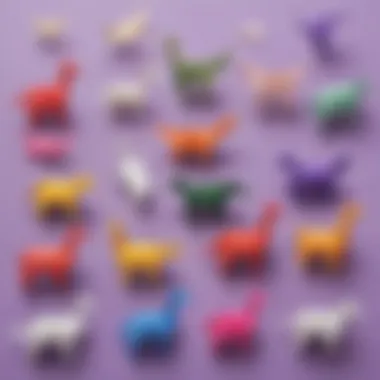Engage Elementary School Kids: Explore Fun Crafts Together


Creative Activities
Craft Ideas: Introducing elementary school children to creative crafts can spark their imagination and enhance their dexterity. Simple yet engaging activities like origami, paper weaving, and clay modeling can stimulate their artistic flair and fine motor skills. These projects not only encourage creativity 🎨 but also promote patience and attention to detail.
Step-by-Step Guides: Providing detailed instructions is crucial to ensure that children can easily follow and complete craft projects. Breaking down each step, from materials needed to the final touches, helps cultivate a sense of accomplishment and boosts problem-solving skills. Clear and concise guidance guarantees that children feel empowered and inspired throughout the creative process.
Educational Value: Engaging in craft activities goes beyond just artistic expression. It fosters cognitive development by improving fine motor skills, spatial awareness, and concentration. Through crafting, children learn to follow instructions, think critically, and explore innovative ideas. These educational benefits make crafting a valuable tool for holistic growth and learning.
Introduction
Crafting is a splendid pursuit that nurtures creativity, dexterity, and ingenuity. In this expansive compendium of crafts tailored for budding artisans, we embark upon a journey into a realm where artistry meets technique, offering youngsters a playground for self-expression and skill enhancement. Engaging in various crafts is not merely about the end product but encompasses the entire process of ideation, creation, and refinement. Crafts serve as a gateway to the development of motor skills, cognitive abilities, and aesthetic sensibilities in children. Through the manipulation of materials and exploration of different techniques, youngsters hone their fine motor skills as they cut, fold, and paint. Moreover, engaging in crafting activities promotes concentration, problem-solving, and critical thinking – integral skills that lay a strong foundation for lifelong learning. The significance of introducing children to diverse crafts lies in its potential to unlock a world of imagination and innovation. By providing them with opportunities to experiment with various mediums and techniques, we empower children to think outside the box, fostering a spirit of curiosity and exploration. Craft activities also foster a sense of accomplishment and pride in the young creators, boosting their self-esteem and confidence. Amidst the fast-paced digital world, engaging in hands-on crafting activities offers a much-needed respite, allowing children to unleash their creativity in a tangible and fulfilling manner. From the delightful art of origami to the tactile joy of fabric painting, each craft offers a unique experience that stimulates the senses and inspires young minds. By delving into the diverse crafts presented in this guide, children embark on a journey of self-discovery and artistic growth, enriching their lives with colors, textures, and boundless possibilities.
Paper Crafts
Paper crafts are an essential component of this article, aimed at introducing elementary school children to the world of creativity and artistry. The significance of paper crafts lies in their versatility and accessibility, making them ideal for young learners to explore their artistic talents. By engaging in paper-based activities, children can enhance their fine motor skills, creativity, and cognitive abilities. Additionally, paper crafts promote imagination and concentration, crucial skills for academic and personal development.
Origami
Origami, the ancient art of paper folding, holds a unique charm in the realm of paper crafts. With origins rooted in Japanese culture, origami offers a blend of creativity and logic, challenging children to follow precise instructions while fostering mindfulness and patience. Through the meticulous folding of paper, young learners can develop spatial awareness, problem-solving skills, and a sense of accomplishment. Origami projects range from simple animals to intricate geometrical shapes, providing a progressive learning experience for children of all skill levels.
Paper Mache
Paper mache, a technique involving the use of paper and adhesive, introduces children to the world of sculpting and 3-dimensional art. By layering paper strips and paste, young crafters can create a variety of objects, from animal masks to decorative ornaments. Paper mache projects encourage experimentation with different textures and forms, enabling children to understand the concept of volume and structure. This hands-on approach to crafting promotes sensory exploration and fosters an appreciation for the tactile aspects of art.
Paper Collage
Paper collage, a creative assemblage of paper cutouts, allows children to explore patterns, colors, and composition. Collage art enhances visual thinking and encourages resourcefulness, as children repurpose paper scraps to create innovative designs. Through collage-making, young artists develop their aesthetic sense, sharpen their attention to detail, and express their individuality. Collage projects can range from simple cut-and-paste activities to complex narrative compositions, offering endless possibilities for self-expression and creativity.
Fabric Crafts


Fabric crafts are a vital component of a well-rounded crafting repertoire, offering a plethora of creative possibilities for young artisans. In this article, the focus on fabric crafts underscores their versatility and tactile nature, providing an avenue for sensory exploration and artistic expression. Fabric crafts encompass a wide range of activities, from sewing projects to fabric painting, each with its unique allure and benefits.
Sewing Projects
Sewing projects introduce children to the fundamental skills of stitching, threading needles, and creating simple yet functional items. By engaging in sewing projects, youngsters enhance their hand-eye coordination, fine motor skills, and patience. Additionally, sewing fosters a sense of accomplishment and self-reliance as children witness their creations gradually taking shape through the art of needle and thread.
No-Sew Fabric Crafts
No-sew fabric crafts offer a convenient alternative for young crafters who may not have access to sewing equipment or prefer a no-fuss approach to crafting. This crafting method involves innovative techniques such as fabric gluing, knotting, or using fabric tape to create charming fabric-based creations without the need for stitching. No-sew fabric crafts promote creativity, resourcefulness, and experimentation, allowing children to explore textures and design without the constraints of traditional sewing.
Fabric Painting
Fabric painting opens up endless possibilities for artistic expression on textile mediums. Through fabric painting, children learn to use fabric-friendly paints, brushes, and stencils to adorn fabrics with vibrant designs and patterns. This form of crafting encourages imagination, color exploration, and personalization as young artists transform plain fabric surfaces into unique masterpieces. Fabric painting not only develops artistic skills but also nurtures a sense of aesthetic appreciation and attention to detail in children. Through the tactile experience of painting on fabric, youngsters engage in a multisensory creative process that stimulates their visual and tactile senses, fostering a deeper connection with their artistry.
Clay and Sculpting
In the vast realm of crafting activities for children, Clay and Sculpting stand out as an essential component that holds a unique fascination for many young enthusiasts. Clay, a versatile medium that allows for tactile exploration, encourages children to unleash their creativity through three-dimensional forms. Sculpting, on the other hand, refines their motor skills and spatial awareness while honing their ability to translate mental imagery into tangible creations.
Diving deeper into the realm of Clay and Sculpting unveils a world of endless possibilities where imagination knows no bounds. For young learners, engaging in clay work nurtures patience, perseverance, and fine motor skills. The tactile experience of manipulating clay promotes sensory development and hand-eye coordination, essential for their overall growth and dexterity. Furthermore, sculpting techniques introduce children to concepts of volume, proportion, and symmetry, laying a foundation for their understanding of spatial relationships.
Pottery, a venerable art form with a rich history, holds a prominent place within Clay and Sculpting. In this subcategory, children learn the traditional craft of shaping clay on the potter's wheel or using hand-building techniques. The process of pottery-making instills discipline and precision as youngsters mold and form clay into functional or decorative vessels. By delving into pottery, children not only refine their motor skills but also cultivate an appreciation for craftsmanship and heritage, fostering a sense of pride in creating objects from a raw material.
Modeling Clay Creations, a favorite among young crafters, offers a more accessible entry point into the world of Clay and Sculpting. Unlike traditional pottery, modeling clay allows for spontaneous and imaginative expression without the need for specialized equipment. Children enjoy the malleability of modeling clay, which enables them to experiment freely and bring their ideas to life without constraints. Through this hands-on activity, youngsters enhance their hand strength and dexterity, fine-tuning their ability to manipulate materials with precision.
Sculpting Techniques constitute a crucial aspect of Clay and Sculpting, encompassing a range of methods that empower children to explore different styles and forms of sculpture. From additive techniques like molding and carving to subtractive methods such as sculpting from a block, young artists develop a keen understanding of form, texture, and composition. By experimenting with various sculpting tools and techniques, children not only expand their creative repertoire but also cultivate problem-solving skills and spatial reasoning essential for artistic growth.
Recycled Crafts
In the realm of creativity and sustainability, Recycled Crafts hold a paramount position in this curated selection of crafts designed for elementary school children. Recycled Crafts not only stimulate artistic expression but also instill a sense of environmental consciousness and resourcefulness in young minds. By repurposing everyday items that would typically be discarded, children learn the value of mindful consumption and the power of imagination in transforming 'waste' into beautiful creations. Thumbnail genuine:bayoility Recycled Crafts introduce young learners to the concept of upcycling, which involves taking existing materials and elevating them into new, valuable products. This process encourages children to think innovatively, problem-solve creatively, and consider the environmental impact of their actions. Throughout this section, we will explore the transformative potential of Recycled Crafts and how they contribute to holistic skill development and ecological awareness.
Upcycled Projects


Through Upcycled Projects, children embark on a journey of reinvention and creativity. By reimagining used items such as plastic bottles, old clothes, or cardboard boxes, young crafters discover the thrill of turning ordinary objects into extraordinary works of art. Upcycled Projects not only challenge children to think outside the box genuine:yaround but also nurture their resourcefulness and sustainability ethos. Creating installations or decor pieces from materials that would otherwise end up in landfills empowers children with the understanding that every object carries untapped potential waiting to be unlocked through creative vision and manual skill. Stay engaged as we delve into the enchanting realm of Upcycled Projects, where ingenuity meets environmental stewardship, shaping the crafting landscape for our young artisans.
Repurposed Materials
Repurposed Materials form the bedrock of sustainable crafting practices. By utilizing items that have fulfilled their initial purpose, such as glass jars, newspapers, or fabric scraps, children learn the art of transformation and reinvention. Repurposing materials challenges them to reimagine the possibilities inherent in objects that others might overlook as trash. This process enhances their critical thinking skills, resource management abilities, and appreciation for the inherent value of materials. The exploration of Repurposed Materials not only expands children's crafting repertoire but also deepens their respect for the environment by showcasing the beauty that can emerge from mindful repurposing. Discover the artistry embedded in everyday objects transformed through the lens of youthful creativity and eco-consciousness.
Recycled Art Ideas
Innovative and inspiring, Recycled Art Ideas offer a plethora of avenues for artistic experimentation and expression. By integrating recycled materials into their artistic endeavors, children develop a keen eye for unconventional beauty and the potential for beauty in unexpected places. Recycled Art Ideas spark imagination, encouraging children to see the world around them through a lens of artistic possibility and environmental responsibility. Whether constructing sculptures from scrap metal or fashioning jewelry from discarded beads, Recycled Art Ideas foster a sense of ingenuity and aesthetic appreciation. Join us as we navigate the enchanting realm of Recycled Art Ideas, where sustainability merges with artistic innovation to cultivate a generation of environmentally conscious creators.
Nature-Inspired Crafts
Nature-inspired crafts hold a significant place in the realm of artistic activities for elementary school children. Embracing elements from the natural world not only sparks creativity but also instills a deep appreciation for the environment. By engaging in nature-inspired crafts, children can develop a stronger connection with the outdoors, fostering a sense of wonder and curiosity towards the beauty and diversity of the world around them. These crafts provide a platform for young minds to explore textures, patterns, and colors sourced directly from nature itself, offering a multi-sensory experience that enhances their cognitive abilities.
Leaf Printing
Leaf printing stands out as a captivating nature-inspired craft that allows children to create unique artistic imprints using leaves found in their surroundings. This craft encourages children to observe and appreciate the intricate details and structures of different leaves. By carefully selecting leaves with varying shapes and sizes, children can experiment with creating patterns and designs by applying paint or ink to the surface of the leaves and transferring these onto paper or fabric. Leaf printing nurtures a sense of creativity and resourcefulness as children explore different combinations and techniques to produce visually striking artworks that celebrate the beauty of nature.
Rock Painting
Rock painting offers a creative outlet for young crafters to transform ordinary rocks into colorful works of art. With a myriad of shapes and sizes to choose from, rocks serve as versatile canvases for expressing artistic ideas. This craft encourages children to find inspiration in the textures and patterns naturally present on the rocks, fostering an understanding of composition and design. Through rock painting, children can explore various painting techniques, color mixing, and patterns, enhancing their fine motor skills and artistic expression. Additionally, painted rocks can be used as decorative pieces or even as imaginative characters in storytelling, adding a playful and personal touch to their creations.
Twig Art
Twig art inspires young artists to harness the beauty of nature's building blocks – twigs. This craft involves gathering twigs of different lengths and thicknesses to construct unique sculptures, wall hangings, or imaginative creations. By assembling twigs into shapes and forms, children can explore concepts of balance, symmetry, and spatial awareness. Twig art encourages children to engage in hands-on experimentation, problem-solving, and creative decision-making as they piece together individual twigs to form cohesive and aesthetically pleasing structures. Through twig art, children not only refine their fine motor skills but also cultivate a sense of environmental stewardship by repurposing natural materials into artful expressions of their creativity.
Holiday Crafts
Crafting during holidays serves as a valuable opportunity for children to engage in creative activities and immerse themselves in the festive spirit. The holidays offer a unique occasion to explore various crafts, fostering artistic expression and skill development. Engaging in holiday-themed crafts not only brings joy and excitement but also enables children to create personalized decorations imbued with meaning and creativity. From Christmas ornaments to Halloween lanterns, holiday crafts provide an avenue for children to express their cultural traditions and showcase their artistic flair.
Seasonal Decorations


Seasonal decorations play a crucial role in enhancing the festive ambiance of holidays and special occasions. When it comes to crafting seasonal decorations, children can unleash their creativity by making beautiful ornaments, garlands, and wreaths that reflect the spirit of the season. Crafting seasonal decorations also allows children to develop their fine motor skills and attention to detail as they engage in cutting, gluing, and decorating various materials. Moreover, creating seasonal decorations can instill a sense of pride and accomplishment in children as they showcase their handmade crafts to friends and family during holiday gatherings.
Gift-Making Ideas
Handmade gifts hold a special place in the hearts of both the giver and the recipient. Encouraging children to participate in gift-making promotes creativity, thoughtfulness, and personalization. From homemade cards to DIY photo frames, gift-making fosters a sense of generosity and appreciation for the effort put into creating meaningful presents. Moreover, engaging in gift-making activities allows children to practice essential skills such as planning, designing, and executing handmade gifts that convey heartfelt sentiments and emotions.
Holiday-themed Crafts
Holiday-themed crafts encompass a wide range of creative projects inspired by various festive occasions throughout the year. Whether crafting Easter eggs, Fourth of July decorations, or Thanksgiving centerpieces, holiday-themed crafts enable children to explore diverse cultural traditions and artistic techniques. Engaging in holiday-themed crafts also encourages children to learn about the significance of different holidays and celebrate them through hands-on crafting experiences. By integrating holiday-themed crafts into their creative repertoire, children can develop a deep appreciation for cultural diversity and artistic expression.
Educational Crafts
In this article exploring various crafts for elementary school children, Educational Crafts play a significant role in enhancing children's learning experience while fostering creativity and skill development. Educational Crafts encompass a wide range of activities that not only stimulate artistic expression but also reinforce academic concepts in a hands-on and engaging manner. By integrating educational elements into crafting projects, children can seamlessly merge learning with play, making the educational experience more enjoyable and effective. Parents and educators alike value Educational Crafts for their ability to enhance cognitive skills, fine motor development, and overall academic performance.
Mathematics Crafts
The realm of Mathematics Crafts offers a unique opportunity for children to embody mathematical concepts through hands-on projects. From constructing geometric shapes to creating patterns and symmetry, Mathematics Crafts provide a tangible way for children to explore mathematical principles in a practical and visual way. Engaging in Mathematics Crafts not only reinforces mathematical knowledge but also enhances problem-solving skills, spatial reasoning, and critical thinking abilities. With a focus on precision, measurement, and calculation, Mathematics Crafts bridge the gap between abstract mathematical ideas and real-world applications, making math more tangible and accessible for young learners.
Science Experiment Projects
Science Experiment Projects ignite curiosity and passion for scientific exploration in children, allowing them to conduct hands-on experiments and observations to deepen their understanding of scientific concepts. Through Science Experiment Projects, children learn to ask questions, form hypotheses, and draw conclusions based on empirical evidence. This interactive approach to learning instills a love for science and nurtures essential skills such as observation, experimentation, and data analysis. Science Experiment Projects also encourage independent thinking, problem-solving, and critical analysis, enhancing children's scientific literacy and preparing them for future academic pursuits in the STEM field.
Language Arts Crafts
Language Arts Crafts blend creativity with literacy skills, offering children a platform to enhance their reading, writing, and communication abilities through artistic expression. From creating storybooks to crafting poetry or designing word puzzles, Language Arts Crafts inspire imagination and cultivate language proficiency in a fun and interactive way. By integrating language-focused activities into crafting projects, children develop a deeper appreciation for literature, grammar, and vocabulary. Language Arts Crafts also promote storytelling skills, linguistic creativity, and verbal articulation, contributing to holistic language development in young learners.
Conclusion
In the sweeping panorama of crafting endeavors, the realm of Conclusion stands as the beacon of analytical contemplation and summative closure. As the veritable crescendo of this expedition through divergent crafts, the Conclusion serves not merely as a terminus but as the fulcrum upon which the cogent insights and transformative gleanings of the preceding sections coalesce.
Amid the kaleidoscope of artistic pursuits delineated in this scholarly tract, the denouement in its maiden sanctum proffers a solace of reflection and a zenith of comprehension. Much akin to the unmistakable scent of fresh parchment, the Conclusion engenders a sense of finality underscored by the resonant chords of elucidation.
At its core, the denouement of this discourse on diverse crafting legacies is not solely a curtain call; rather, it is a symphonic crescendo that reverberates through the corridors of young minds imbued with the spirit of ingenuity. Emphatically, the journey through the myriad crafts converges at the threshold of the Conclusion, where epiphanies await and revelations unfold.
Moreover, the utmost significance of this conclusive juncture lies in its holistic retrospection and projection. Not a mere exegesis in isolation, the Conclusion of this veritable compendium resonates with the depth of intellectual inquiry that encapsulates the essence of creativity in its multitudinous forms.
In essence, the Conclusion is not a terminus; it is a gateway to further exploration and introspection for young creators navigating the boundless realms of artistic pursuit. As the curtain descends on this tapestry of crafting lore, it leaves behind a trail of inspiration, beckoning the intrepid souls of tomorrow to chart their course through the uncharted waters of limitless imagination.







